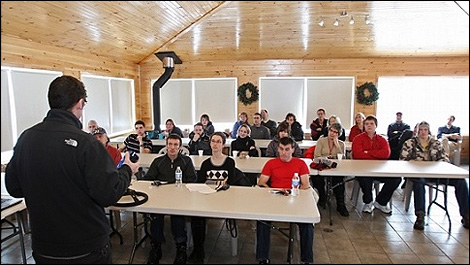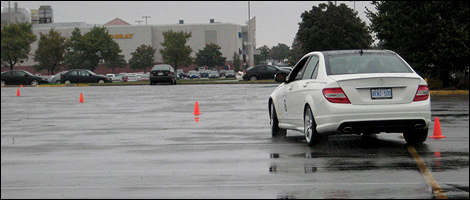Jun
15th
Stay connected Subscribe to our RSS feed
You're 16, and you just obtained your driver's license. You've got a job and are looking to buy your first car; your parents might even be willing to help you pay for it, because they're sick and tired of hauling you and your buddies around at any given time of the day. Or night.
Naturally, a brand-new car would be the best choice if money's not a big issue. On the other hand, insurance premiums for teenagers are extremely high, because of their inexperience behind the wheel and the risk involved. Everybody knows that.
I thought I had the best advice on this issue, but I might be wrong. Parents asking me what car they should buy for their child are obviously concerned about safety above anything else, even price.
My opinion used to be that a teenager should start off with a used, inexpensive car. A beater. These kids need a lot of practice in many conditions such as traffic, parallel parking, high speeds as well as Old Man Winter. They'll likely dent their car, back up into a lamppost, scrape a bumper or two, slide through a slippery intersection and discover what happens to an engine when you never check its oil level.
However, an old car might not be equipped with all the safety features included in a new car, such as a full array of airbags, electronic stability control and a blind-spot monitor.
A friend's teenage son bought himself a brand-new Volkswagen Jetta, and was involved in an accident a few months later. He was driving down a country road early in the morning on his way to work, when a fox suddenly crossed the road. In an attempt to avoid it, he lost control and spun the car into a ditch; the Jetta rolled over, triggering every airbag. The car was a write-off.
The kid walked away from the crash with only a few bruises. He wasn't speeding. He was sober. He was belted. He wasn't texting or talking on the phone. He was alone in the car. He just swerved too sharply and couldn't recover, a manoeuvre he didn't know how to handle, because no one taught him how to react in a panic situation.
Long story short, the only thing injured was his pride. If he were driving a beater however, he might still be in the hospital right now. As much as I think manufacturers are going nuts adding a gazillion airbags into new cars, I must admit they proved their usefulness in this case. And I'm now reconsidering my opinion that beginners should drive beaters until they gain more experience.
But more importantly, advanced driving courses teach you what to do in this type of situation; they show you what a car, new or used, is capable of in terms of manoeuvrability and braking. I believe a lot of people likely never performed an emergency lane change or slammed on the brakes with all their might, and have no idea how their vehicle will react.
Buying a new (read: safer) car for their teenage kid might not be possible for everyone, because it's a big investment. On the other hand, advanced driving courses, as well as winter driving courses, usually cost a few hundred dollars and are worth every penny for ensuring your safety, or a loved one's safety. Consider them seriously.
Naturally, a brand-new car would be the best choice if money's not a big issue. On the other hand, insurance premiums for teenagers are extremely high, because of their inexperience behind the wheel and the risk involved. Everybody knows that.
 |
| Photo: Auto123.com |
I thought I had the best advice on this issue, but I might be wrong. Parents asking me what car they should buy for their child are obviously concerned about safety above anything else, even price.
My opinion used to be that a teenager should start off with a used, inexpensive car. A beater. These kids need a lot of practice in many conditions such as traffic, parallel parking, high speeds as well as Old Man Winter. They'll likely dent their car, back up into a lamppost, scrape a bumper or two, slide through a slippery intersection and discover what happens to an engine when you never check its oil level.
However, an old car might not be equipped with all the safety features included in a new car, such as a full array of airbags, electronic stability control and a blind-spot monitor.
A friend's teenage son bought himself a brand-new Volkswagen Jetta, and was involved in an accident a few months later. He was driving down a country road early in the morning on his way to work, when a fox suddenly crossed the road. In an attempt to avoid it, he lost control and spun the car into a ditch; the Jetta rolled over, triggering every airbag. The car was a write-off.
The kid walked away from the crash with only a few bruises. He wasn't speeding. He was sober. He was belted. He wasn't texting or talking on the phone. He was alone in the car. He just swerved too sharply and couldn't recover, a manoeuvre he didn't know how to handle, because no one taught him how to react in a panic situation.
Long story short, the only thing injured was his pride. If he were driving a beater however, he might still be in the hospital right now. As much as I think manufacturers are going nuts adding a gazillion airbags into new cars, I must admit they proved their usefulness in this case. And I'm now reconsidering my opinion that beginners should drive beaters until they gain more experience.
But more importantly, advanced driving courses teach you what to do in this type of situation; they show you what a car, new or used, is capable of in terms of manoeuvrability and braking. I believe a lot of people likely never performed an emergency lane change or slammed on the brakes with all their might, and have no idea how their vehicle will react.
Buying a new (read: safer) car for their teenage kid might not be possible for everyone, because it's a big investment. On the other hand, advanced driving courses, as well as winter driving courses, usually cost a few hundred dollars and are worth every penny for ensuring your safety, or a loved one's safety. Consider them seriously.
 |
| Photo: Michel Deslauriers |
 The latest auto news, reviews, prices, product and vehicle releases.
The latest auto news, reviews, prices, product and vehicle releases.